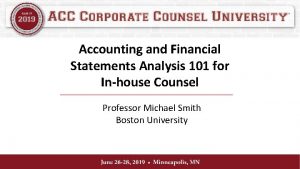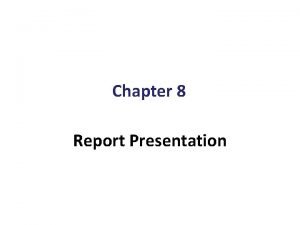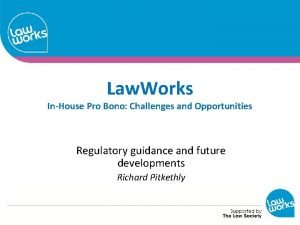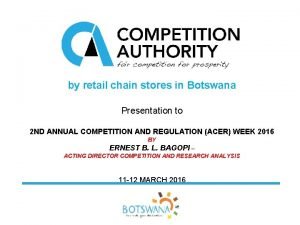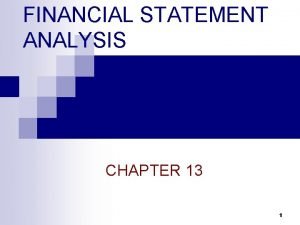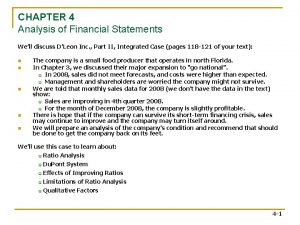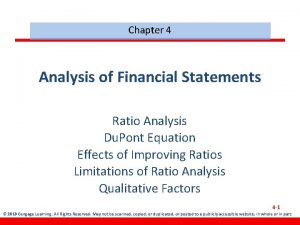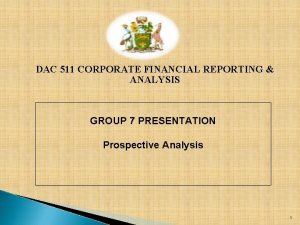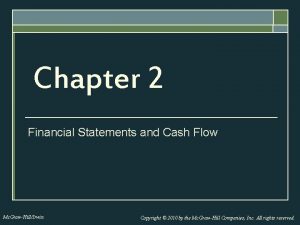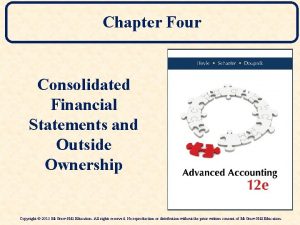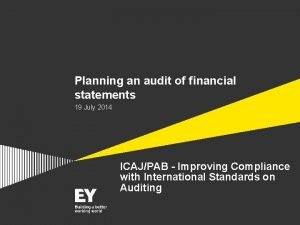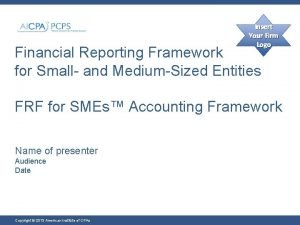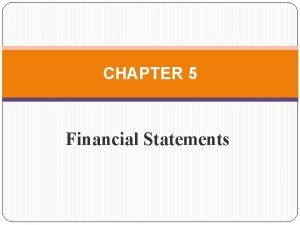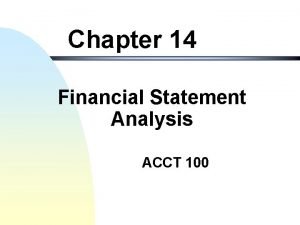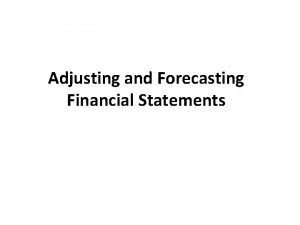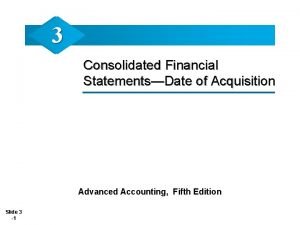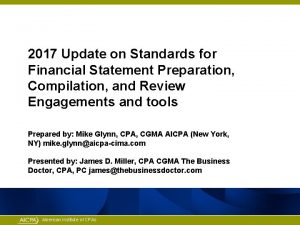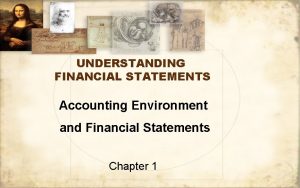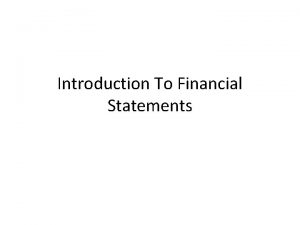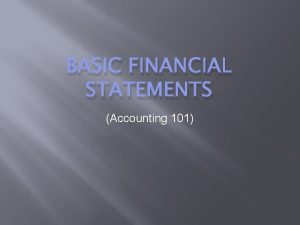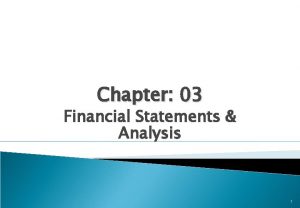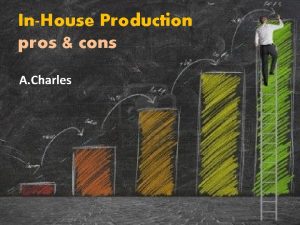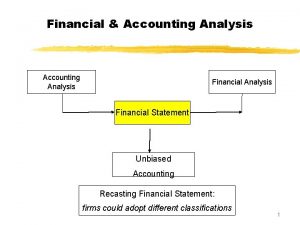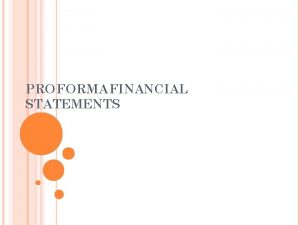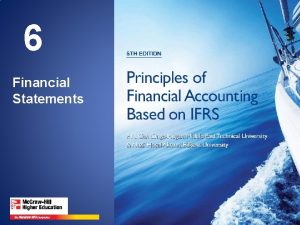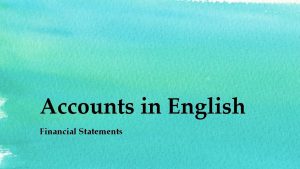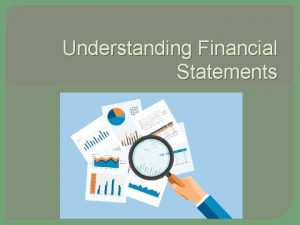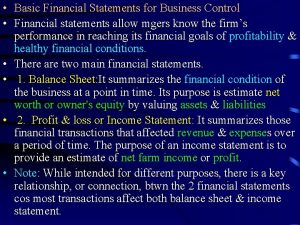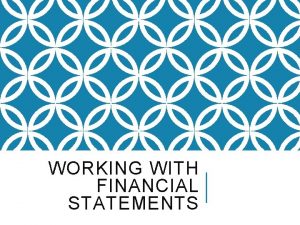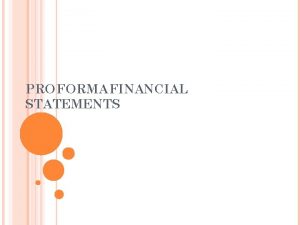Accounting and Financial Statements Analysis 101 for Inhouse





























- Slides: 29

Accounting and Financial Statements Analysis 101 for In-house Counsel Professor Michael Smith Boston University

Session Overview • • Institutional context Financial statements – – – Balance sheet Income statement Statement of cash flows Format? Purpose? Measurement?

Regulatory Oversight • • The Financial Accounting Standards Board (FASB) has responsibility for developing Generally Accepted Accounting Principles (GAAP) The Securities and Exchange Commission (SEC) is responsible for enforcement of accounting rules. Independent auditors review financial statements and provide an opinion. The Public Company Accounting Oversight Board (PCAOB) has responsibility for oversight of auditing.

• • SEC Filings Form 10 -K – Management’s Discussion and Analysis – Financial Statement – Footnotes to Financial Statements Form 8 -K – • Prompt notification of significant events Proxy Statement (14 -A) – – Required when soliciting votes Details on executive and board compensation

The Balance Sheet Assets = Uses of funds Productive capacity Liabilities + Owners’ Equity Creditors’ Claims Owners’ Claims Sources of funds (Financing) Capital structure refers to the relative amounts of debt and equity in a firm’s financing.

Purpose of Balance Sheet • Provides investors with information about: – – – • the nature and amounts of the firm’s productive assets. the firm’s capital structure (relative amounts of debt and equity) and financial risk. the firm’s financial flexibility and liquidity (how quickly assets and liabilities will generate or consume cash). The information is most useful to creditors: – Little information about the firm’s earnings potential.

Balance Sheet Vocabulary • Asset: resource owned by a firm whose benefits can be measured with a reasonable degree of precision. • Liability: a firm’s debts or obligations, settled over time through the provision of cash, goods, or services. • Owners’ equity: the residual claim of owners against the net assets of the firm.

Facebook Balance Sheet Assets Cash Marketable securities Accounts receivable, net Prepaid expenses Total current assets Property and equipment, net Intangible assets, net Goodwill Total assets Liabilities Accounts payable Accrued expenses and other Total current liabilities Other long-term liabilities Total liabilities Equity Contributed capital (additional paid in capital) Retained earnings Total stockholders’ equity Total liabilities + equity 2016 8. 903 20, 546 3, 993 959 34, 301 8, 591 2, 535 19, 434 64, 961 2015 4, 907 13, 527 2, 259 659 21, 652 5, 687 3, 246 18, 822 49, 407 302 2, 573 2, 875 2, 892 5, 767 196 1, 729 1, 925 3, 264 5, 189 38, 227 20, 967 59, 194 64, 961 34, 886 9, 332 44, 218 49, 407

Accounting Assets • Resources whose benefits can be precisely measured: – Cash, inventory, accounts receivable, property, plant and equipment, investments in other firms, intangible assets purchased from another firm, – Reported as assets on the balance sheet • Resources whose benefits cannot be precisely measured: – Research and development, advertising, brand names, internally generated intangible assets – Not reported as assets on the balance sheet

Goodwill • Goodwill arises only from merger & acquisition activity. • Goodwill is the premium of price paid over the market value of the identifiable assets purchased net of the market value of the identifiable liabilities assumed.

Asset Write-Downs • If the market value of a long-term asset is lower than its book value, the company must reduce (write down) the asset on the balance sheet and take a corresponding loss on the income statement. • The following terms are synonymous: • Asset impairment • Write-down • Write-off (write-down to 0)

Liabilities • Examples of obligations reported as liabilities on balance sheets: – Accounts payable, unearned revenue, debt, wages payable, taxes payable, utilities payable, etc. • Legal obligations to make payments are not necessarily accounting liabilities: – Some lease contracts • Losses related to litigation accrued if sufficiently probable and estimable.

Owners’ Equity • Additional paid in capital is the cumulative amount of cash generated by primary stock issuances. • Retained earnings is the cumulative amount of profits reinvested in the firm. • Treasury shares is the cumulative value of shares repurchased by the firm less the value of those shares reissued.

Balance Sheet Caveats • Almost all asset and liability accounts are based in part on management’s estimates • GAAP does not allow the recognition of internally generated intangible assets on the balance sheet. • Some liabilities (and the assets financed by them) may not be on the balance sheet.

Income Statement • Report of profitability for a period of time. • Based on the accrual method of accounting • Income does not necessarily correspond to operating cash flows in a given year; over time these amounts will reconcile.

Purpose of Income Statement • Provides investors with information about – earnings generated by the firm in the past fiscal year and its ability to generate wealth in the future. – the various revenues, expenses, gains and losses of the firm • The information is most useful to stock investors.

Facebook Income Statement Revenue Cost of revenue Research and development Marketing and sales General and administrative Income from operations Interest expense, net Provision for taxes Net income 2016 27, 638 ( 3, 789) ( 5, 919) ( 3, 772) ( 1, 731) 12, 427 ( 91) ( 2, 119) 10, 217 2015 17, 928 ( 2, 867) ( 4, 816) ( 2, 725) (1, 295) 6, 225 ( 31) ( 2, 506) 3, 688

Accrual Accounting: Expenses Matching principle: Expenses are recognized in the period in which the associated revenues (or benefits) are earned, without regard to the timing of cash payments.

Criteria for Revenue Recognition • Income is earned – i. e. , the work is “done” • Income is realizable – i. e. , have received an asset in exchange for the work

Example of Revenue Recognition • Product bundle, 5 year contract • Copier • Extended warranty (for years 2 through 5) • Annual maintenance (all 5 years) • A single price for all elements of the bundle • Customer pays cash upfront • When can the company record revenue on the income statement?

When is Revenue Recognized? Allocate price to “buckets” Price Copier Record revenue immediately Extended warranty Annual maintenance Record revenue in years 2 through 5 Record revenue in years 1 through 5

EBIT and EBITDA • Managers often believe that bottom-line net income does not capture the real value created by the company. • EBIT (Earnings Before Interest and Taxes) and EBITDA (Earnings Before Income, Taxes, Depreciation and Amortization) make adjustments to bottom-line net income to represent (presumably) more accurately the profits and/or cash flows generated from operations. • Managers are more often compensated based on some variation of EBIT or EBITDA than bottom-line net income.

EBIT and EBITDA • What is the explanation for the exclusions? • Interest expense • Related to financing choices, not operating efficiency • Reduces comparability across companies with different capital structures • Tax expense • Related to the vagaries of tax laws • Reduces comparability across companies • Depreciation and amortization • Non-cash expenses related to transactions that occurred in the past • Reduces comparability across companies • Managers are more often compensated based on some variation of EBIT or EBITDA than bottom-line net income.

Facebook: EBIT and EBITDA GAAP 10, 217 GAAP Earnings Add back Interest expense Tax expense Depreciation and amortization Total 10, 217 EBITDA 10, 217 +91 +2, 119 12, 427 +91 +2, 119 +2, 342 14, 769

Statement of Cash Flows • Reports cash flows during a period related to the firm’s operating, investing, and financing activities.

Purpose of Statement of Cash Flows • Does the firm generate enough cash to make its debt payments in the next period? • Does the firm generate enough cash to finance growth with internal funds, or will it have to raise money by issuing stock or debt?

Classification of Activities on SCF • Operating activity – Cash receipts from sales – Cash payments to suppliers – Cash payments to employees • Investing activity – Cash payments for property, plant, equipment, intangible assets, acquisitions. – Cash receipts from sales of long-term assets. • Financing activity – Cash receipts/payments related to debt – Cash receipts from stock issuances – Cash payments for dividends and stock repurchases

Facebook Statement of Cash Flows 2016 16, 108 Cash flow from operations Investing activities Purchases of property and equipment Sales (purchases) of securities, net Acquisitions of businesses, net Cash flow from investing ( 4, 491) ( 7, 186) ( 62) ( 11, 739) Financing activities Proceeds from stock issuance Repayment of long-term debt Cash flow from financing ( ( Effect of exchange rate fluctuations Change in cash Beginning balance, cash Ending balance, cash -310) ( 63) 3, 996 4, 907 8, 903 2015 10, 320 ( 2, 523) ( 6, 700) ( 211) ( 9, 434) ( ( --139) (155) 592 4, 315 4, 907

Main Takeaways • Format and purpose of main financial statements • Rules underlying measurement of assets, liabilities, revenues and expenses. • Alternative definitions of income
 Inhouse financial statement
Inhouse financial statement Aasb 101 presentation of financial statements
Aasb 101 presentation of financial statements Tchc inhouse
Tchc inhouse Inhouse rpo
Inhouse rpo Inhouse brands
Inhouse brands Inhouse journal
Inhouse journal Unit 13 accounting and financial statements
Unit 13 accounting and financial statements Financial accounting chapter 1
Financial accounting chapter 1 Chapter 03 financial analysis
Chapter 03 financial analysis Financial statements and ratio analysis chapter 3
Financial statements and ratio analysis chapter 3 Commercial banks financial statements and analysis
Commercial banks financial statements and analysis Investment center ppt
Investment center ppt Analysis of financial statements
Analysis of financial statements Chapter 4 analysis of financial statements
Chapter 4 analysis of financial statements Chapter 4 analysis of financial statements
Chapter 4 analysis of financial statements Prospective analysis financial statements
Prospective analysis financial statements 2-2 journal: financial statements and cash flow management
2-2 journal: financial statements and cash flow management Flow chapter 2
Flow chapter 2 Consolidated financial statements and outside ownership
Consolidated financial statements and outside ownership Financial statements purpose
Financial statements purpose Audit planning memorandum ey
Audit planning memorandum ey Sample notes to financial statements for small entities
Sample notes to financial statements for small entities Foreign currency translation example
Foreign currency translation example Objectives of financial statements
Objectives of financial statements Acct 100
Acct 100 Forecasted financial statements
Forecasted financial statements Adjusting accounts for financial statements chapter 3
Adjusting accounts for financial statements chapter 3 Consolidated financial statements date of acquisition
Consolidated financial statements date of acquisition Ssars 21 engagement letter example
Ssars 21 engagement letter example Which item is a constraint in financial accounting?
Which item is a constraint in financial accounting?
